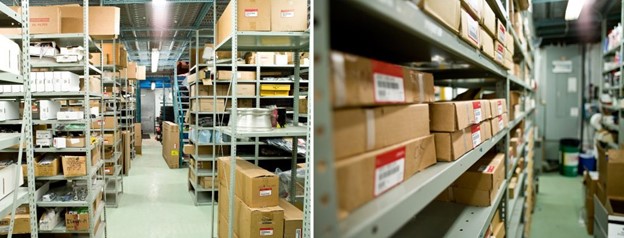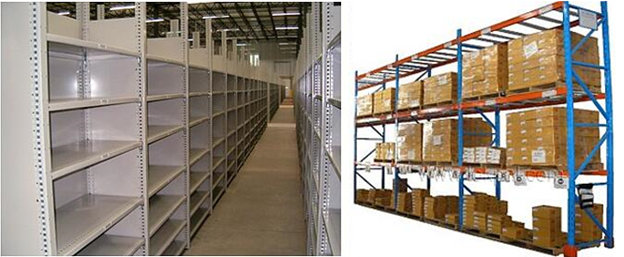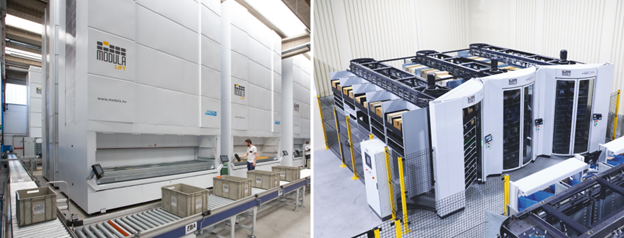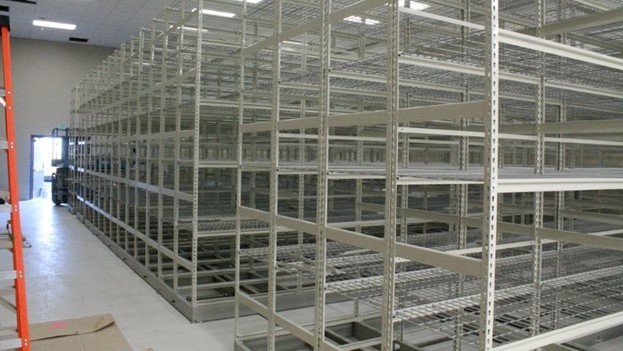TRADITIONAL SHELVING AND RACK SYSTEMS VS AUTOMATED STORAGE AND...
by Scott Olpin, on April 2, 2021
Automated storage and retrieval systems (AS/RS) can provide the most efficient way to save resources over traditional shelving and rack systems. Why? They boost picking productivity, optimize order fulfillment, and aid worker safety.
Businesses have always stored items on different types of freestanding stationary shelving or racking. These types of systems will always have a place in fulfilling storage needs, and they are indeed traditional, straightforward, and seemingly cost-effective. But depending on your type of operation there are hidden costs that could negate the cost-effectiveness of stationary shelving.
This article will take a brief look at the weaknesses and strengths of some of the most common traditional warehouse storage solutions. For a more comprehensive treatment of traditional static shelving, see this article: “Understanding the Different Types of Freestanding Stationary Shelving”.
WEAKNESSES AND STRENGTHS OF STATIC SHELVING

Overall, in larger warehouse-type operations, traditional static storage solutions can be inefficient because:
- They waste space – eating up valuable real estate
- They waste time – increasing employee costs
- They pose a safety hazard in the form of items dropping from shelves, employees falling from ladders or carriers, or injuries caused by twisting, bending, lifting, and reaching for weight loads at different angles. Each of these safety issues creates loss of employee productivity and increased worker compensation liability
Industrial shelving and racking

Industrial shelving is a sturdy storage system typically used in warehouses and factories for small goods. Industrial shelving can be multi-level. Operators pick up and place goods by hand reaching from floor level or with a ladder. Typically all stocking and retrieving is done manually.
Racking is rated even heavier for weight load capacities, is generally wider, deeper, and stacked higher than shelving. Forklift trucks and cherry pickers are commonly used to load and unload materials such as large boxes or entire pallets. The lower levels of racks can also be used for hand-stacked storage.
This type of storage solution can take advantage of the vertical space of a warehouse facility reaching heights of up to 32 feet or more. But they all have the same inefficient use of horizontal space. Moreover, they require the use of forklifts, which themselves can be dangerous to operate.
Conventional shelving: 4-Post, Divider and Case-type shelving

One of the most common warehouse shelving types is conventional 4-Post and Divider, shelving. Case type shelving is most often used in libraries and education facilities. These types of shelving can be very effective in most types of business environments from medical offices to museums, libraries, and any area where open shelving storage is preferable.
Mobile pallet racking
Mobile pallet racking and shelving is mounted onto tracks instead of the floor, allowing increased storage flexibility. Mobile shelving eliminates the need for multiple fixed aisles, as the aisles open up when directed by an operator. While this system is very effective in doubling or tripling the storage capacity of a warehouse, the sliding racks take time and materials are accessed in much the same manner as industrial and conventional shelving. It reduces productivity similar to conventional shelving systems.
HIDDEN COSTS COMMON TO ALL STATIC SHELVING
Time Wasted
Static shelving rows are generally placed at least 3-4 feet apart for operator access, with additional aisle space, up to 10-12 feet, for machine access. One of the biggest problems with this type of warehouse storage solution is the amount of time wasted going up and down rows whenever an operator has to store and pick a product, reducing productivity.
Lack of visibility is also a time waster. Looking for items stored in boxes or containers, located behind other product, and searching for items above and below eye level takes time! The reverse is also true for stocking inventory on static shelving.
Space Wasted
In addition to the space needed for access aisles, there is a lot of space wasted between the horizontal shelves. Typically there’s empty space between shelves for access to taller items and items stored behind front facing storage – creating a lot of unused “air.”
For these reasons, conventional shelving systems take up a lot of real estate, requiring large spaces. The Winter 2020 US industrial and logistics report from Colliers International shows that industrial rents in the U.S. have increased 5.6% year-over-year. So conserving real estate is obviously important from a cost-control perspective.
Safety Issues
Because goods are handled manually, static shelving poses hazards to its workers. Safety issues range from the stresses and strains of retrieving materials manually all day to the danger of items falling from a high shelf, especially when using a ladder or hoist. Workers are also in close proximity as they pass in the aisles between shelves, which keeps them from maintaining social distancing necessitated by Covid-19.
AUTOMATED SHELVING WITH A VERTICAL LIFT MODULE OR HORIZONTAL CAROUSEL

The sheer volume of product inventory and inherent safety hazards have required a rethinking of how items are stored and retrieved in warehouses and factories. The rise of automated storage systems provides solutions to the above issues:
- Reducing space requirements by up to 90 percent
- Dramatically boosting efficiency, and
- Increased worker safety
Automated storage and retrieval systems, known as vertical lift modules (VLMs) and horizontal carousels are a complete departure from traditional static shelving.
What is a VLM?
A VLM is a tall device resembling a vending machine, with 2 facing rows of internal shelves that hold inventory and goods. The machine helps optimize the adjustable shelves and arranges the stored goods to maximize the VLM’s capacity. As a result, a Modula VLM can save up to 90 percent of the space requirements for a warehouse. For more information on VLMs, see this article, “What is a Vertical Lift Module and How does It Benefit My Business”?
An operator can have items automatically retrieved from within the VLM and delivered at an ergonomically proper angle by tapping an easy-to-use screen. Instead of walking around static shelving on the warehouse floor to find stored items, the items are delivered to where the worker stands. The VLM eliminates multiple, expansive aisles and scattered shelving, greatly reducing space requirements and dramatically enhancing productivity.
Following the parts-to-pickers principle, the automated warehouse storage solutions deliver the items directly to the operator. This reduces handling times both in picking and replenishing. Using visual picking aids, the operator can quickly identify which item should be picked along with the quantity requested. This fosters high picking rates and dramatically improves picking accuracy.
A horizontal carousel (HC) works in much the same way, except the items move horizontally rather than vertically. Horizontal carousels by nature do not utilize vertical space as well as a vertical warehouse (VLM). However, they can still save up to 60% of your floor space. They also provide a much higher density storage capacity than racks or shelves.
Safety First
Safety concerns created by traditional shelving are virtually eliminated by the VLM and HC -- no more stress or strain from lifting items from awkward angles; no more risk of falling items from up above; and compliance with social-distancing requirements is inherent. Workers are less fatigued and more productive. Employers reduce labor costs associated with injuries, liability insurance, and downtime.
CONCLUSION
Automated storage and retrieval systems such as the Modula VLM and Horizontal Carousel are increasingly considered the best way to meet the inventory management demands of modern warehouses. No other warehouse storage solution can match a Modula VLM for saving space, boosting productivity, and keeping your warehouse operations safe.
Do you wonder if integrating an automated warehouse storage solution is right for your business operations? Contact a storage specialist. With a combined 100 years of experience in storage solutions, we will be able to answer your questions and make recommendations based on your needs.
P.S. Is there any other storage topic you want to hear about? We welcome your suggestions and comments below.




